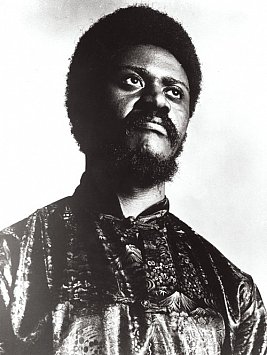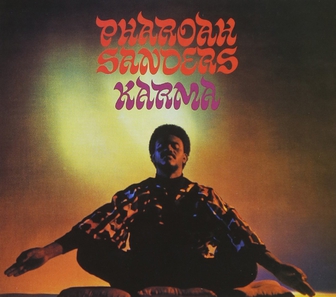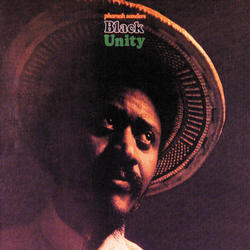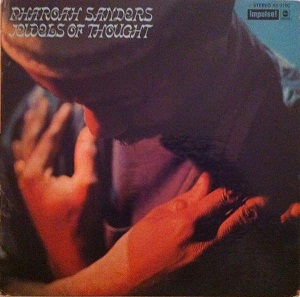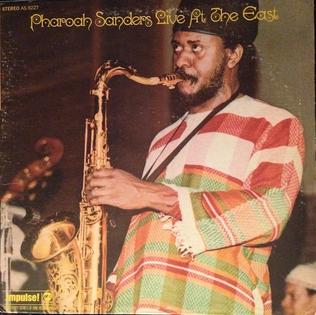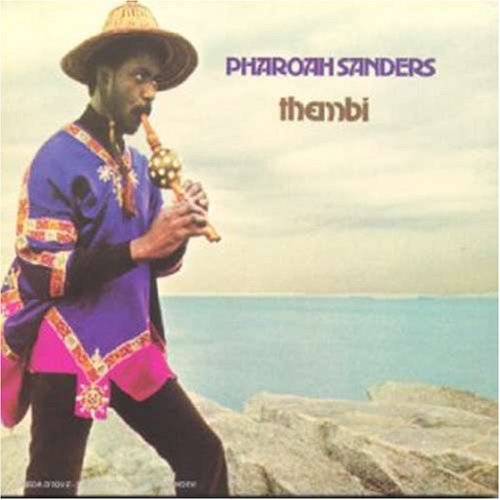Not a fan of Led Zeppelin, The Clash’s Paul Simonon once opined: “Just looking at their album covers makes me want to throw up.”
When it comes to Pharoah Sanders, who passed away this weekend aged 81, all I have to do is consider one of his album covers and I’m transported. Not just to another time, but other places I’ve never been and, without the sublime fulfillment of his vision, couldn’t imagine. From an era of album covers as art, if forced to choose from a single portfolio, Sanders is my ride or die.
During the late ‘60s and well into the following decade, Sanders could be credited for expanding the work of late-stage John Coltrane, and ably attempting to create a wider-reaching, inclusive music. Like the best avant-garde art, it cannot help straining forward even while remaining inexorably grounded in tradition. It is, above all, adventurous and it takes risks. It’s never manipulative but it might manage to make you scrutinize the world—and yourself—a bit more differently or carefully. The only people who could possibly object to that possibility were never going to listen to this music in the first place.
Sanders was always at his best when he balanced the extremes. His more mellow work (especially that which deploys the flute) is consistently dazzling, while his saxophonic shrieking can be seriously off-putting (to say the least). His catalog comprises the work of a confident explorer willing to go anywhere and do anything. As indicated above, a cursory glance at any of Sanders’s unsmiling album covers from his peak period (late ‘60s to mid ‘70s) makes the conditions clear: strap in and come along for the ride because once we start we aren’t slowing down. This is music that requires an opened, transmutable mind, but it more than meets you half-way, opening up vistas and reflections you would never conceive of on your own. That, of course, is the magic of creation: it’s a shared experience.
For the uninitiated, we might begin by considering what’s arguably his best-known (best? Infamous? controversial? visionary? All of the above?) pieces, the 30 minute-plus marathon “The Creator Has a Master Plan” (from 1969’s Karma). When we talk about taking flight, this offering is not a taxi shuttle across town: this is real flight, with lift-off, intense ascent, a leveling off and cruising at 30,000 feet, with occasional turbulence (and yodeling). It’s everything we tend to love and loathe about this era, but it’s much, much more.
A few words about 1969. The same year King Crimson was pushing pop music into entirely different spheres with the seminal progressive rock cornerstone In the Court of the Crimson King (a great deal more about that album, and that band.) In 1969 our culture was ripe for, if not revolution, evolution, and this is reflected in the art spanning all genres: the most creative amongst us were both receiving and transmitting these vibrations. From a previously published piece assessing the state of affairs, circa ’69:
Importantly, this was not a pose and it was not reactionary; it was a revolution in music: it still manages to seem somehow ahead of its time as well as — it must be said — timeless. This was, in every possible sense, an entirely new sort of music: a collective of superlative craftsmen, united in the effort to create art so original, so unmotivated by commercial appeal, so honest, it couldn’t not be transformative.
Karma—and the albums that both preceded and followed it, by Pharoah and his compatriots—provided the foundation of what came to be known as Spiritual Jazz, combining what we commonly call world music with a focus on the art form’s Afrocentric roots, Eastern innovations, pulling in blues, all of jazz tradition (e.g., mastery of form with improvisation) and a restless exploration. Spiritual music, in short, epitomizes the notion of traveling great distances to arrive inside your own personal space. Like all challenging art, it’s that simple, that impossible.
It’s not remotely coincidental that Sanders ran in circles that included Sun Ra, Ornette Coleman, Don Cherry, and, of course, John Coltrane. These icons were not interested in “music for music’s sake” any more than people like this live “life for life’s sake.” Their primary concern was breaking down the barriers between work, play, purpose, and passion; creating a way of thinking and being that embraces the quest for peace (personal, spiritual, universal) and the inherent dissatisfaction of the seeker, who has to push boundaries and experience the world in novel ways.
Having already lent his services to some of her late husband’s most incendiary sessions, Sanders kicked off the next decade by joining Alice Coltrane on two albums that are practically blueprints for everything already discussed. While the second, Journey in Satchidananda, is more famous (and, depending on your tastes, preferable), it’s his contribution to their first collaboration, Ptah, the El Daoud, that showcases Sanders at his most ethereal. “Blue Nile” is a peak spiritual jazz experience: the interplay between Sanders’s flute, Coltrane’s gorgeous harp and Ron Carter’s irresistible bass groove is sweetly disorienting, prodding gently and pulling the listener along, as though flowing from the river that gives the song its title. (Incidentally, while his work with John Coltrane included some of the most intense of either man’s career, it’s his flute duet on the elegiac almost impossibly beautiful “To Be” that, for this listener, represents the pinnacle of their brief but revelatory partnership.)
Just about everything Sanders touched from the mid ‘60s to the mid ‘70s turned to bliss, and the joys contained within releases like Jewels of Thought, Deaf Dumb Blind (Summun Bukmun Umyun), Black Unity, Live at the East, and Village of the Pharoahs cannot be more highly recommended (I’m particularly pleased to see the Wikipedia entry for Village features my PopMatters appraisal from 2011). The adventurous listener is advised to simply dive in and drink deeply.
On a personal note, a few words on a personal favorite, 1971’s Thembi, seem appropriate. On this outing, Sanders is credited with playing the following instruments: tenor and soprano saxophones, alto flute, koto, brass bells, balaphone, maracas, cow horn, and fifes. You either get that or you don’t; it either fascinates and thrills you, or it doesn’t. This level of insatiable restlessness, the seeking to find suitable sounds and feelings, can be traced to lessons learned from his mentor John Coltrane. In many ways Sanders carried the torch Trane could no longer hold once cancer prematurely robbed him of his life in 1967.
“Astral Traveling” (with the great Lonnie Liston Smith and the supremely underrated Cecil McBee): this is everything; it’s a vibe, it’s an epiphany, a career. (And don’t think fellow seeker Carlos Santana wasn’t paying close attention: listen to the opening groove of this song and then cue up the first track from Caravanserai—imitation always being the most sincere form of flattery).
As Sanders aged, elegantly, into his role of elder but ageless statesman, his productivity never slackened, and if the results were understandably mixed, he was still creating some of his best work (“Harvest Time” from 1976’s Pharoah and the title track from 1981’s Shukuru sit quite comfortably alongside anything he did during the run of masterpieces from his indescribable prime).
By the 1990s, if there weren’t folks clamoring for more of this, it’s fair—if depressing—to concede there weren’t necessarily people clamoring for this music even during the era it was semi-fashionable. But certainly, more people had at least heard of Pharoah Sanders. Then again, more people had heard of jazz then. Therein lies the beauty of this music (jazz in general and Sanders in particular): it was not created with commercial intent and no jazz musician ever becomes a professional expecting to make an easy living. Nevertheless, he persisted, and helped catch indelible lightning in a recording studio on at least two more occasions during this decade.
In 1991 he joined forces with Elvin Jones and Sonny Sharrock, two men who could match his ferocity and power, note for note. The result, Ask the Ages, is an out-and-out masterpiece, as important and meaningful in its way as Karma or Thembi. Anyone with ears can understand the magnitude of these sounds. Although the lovely “Who Does She Hope To Be?” is a tour de force (and any of the six tracks can ably represent the whole), it’s “Many Mansions” that boasts these superheroes bringing the sweet pain like old gods on Mt. Olympus using this planet as their plaything. Listen and remember: It’s okay to be afraid; that is what happens just before you break through to the bright lights.
Improbable as it would seem, Sanders was far from finished. Obviously energized by the indefatigable Bill Laswell, the interplay on 1996’s Message from Home is, at times, as close to apex-level performance as anything either man ever did. “Ocean Song” is a tone poem featuring Pharoah at his most peaceful—a truly tranquil and restorative meditation.
The story never really ended. Sanders seldom slowed down and continued exploring, unstoppable and iconoclastic to the end. He had one final miracle to deliver: Promises, a 2021 collaboration with Floating Points and the London Symphony Orchestra. I wept when I first saw this video and I’m weeping today, watching it. While I’m sad he’s no longer with us, these are tears of extreme awe. That this beautiful man, who knew exactly what he was trying to do, kept perfecting his craft and himself, and in the very last years of his life was still pushing ahead, seems to me the model of existence. To be the messenger of joy and discovery, what a profound gift to humanity. (I’m struck, again, by the poignance of Sanders’s humility throughout this New Yorker interview; even after all he’d done he wasn’t certain he fully realized his potential, not sure he’d captured the sounds he heard in his head, connecting him with every sensitive genius ranging from Shelley and Coleridge to Sonny Rollins and Martin Scorsese.)
Some, arguably, are chosen, gifted not with talent so much as the quest to refine it. At some point they then make a choice: settle in or keep pushing, not owing to ego or an appetite for posterity, but because it’s an all-in proposition. In a world increasingly filled with hollow human beings solely focused on material game or power for its own sake, a man like Sanders is both antidote and inspiration; if more of us aspired to this purer path, maybe we could conceive of a Creator with a Master Plan.)
What do we ask of an artist?
To tell their truth by living it, and vice versa. To translate the things they’re able to see or hear or understand and provide us with everything from enjoyment to enlightenment. The rarest ones are able to consistently balance pleasure and profundity, pushing themselves in ways that obliges their followers to do the same. This dynamic is transformative, and entirely positive. Pharoah Sanders spent more than half a century exploring and refining his vision, and his legacy is helping the world hear, see, and be differently.
